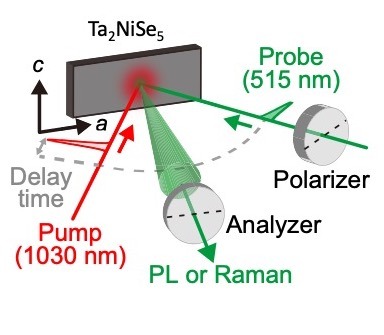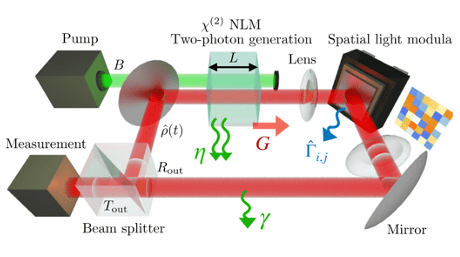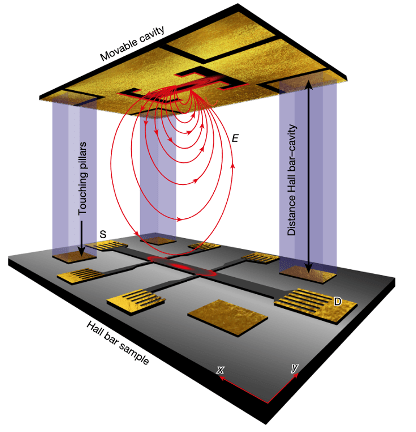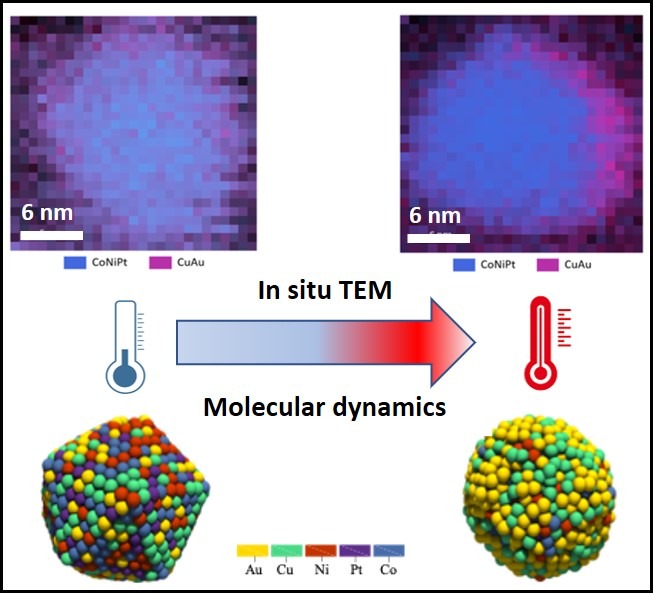Many-body interactions in quantum materials are one of the main drivers of exotic ground states, such as Mott insulators, superconductors, and density waves.

Figure:
Two-color polarization resolved time resolved Raman scattering set-up. The pump pulse at 1030 nm drive the system out-of-equilibrium and the dynamics is probed by a time delayed pulse at 515 mn.
In narrow-gap semiconductors or semimetals, the Coulomb interaction between electrons and holes may lead to a spontaneous formation of excitons. These excitons are expected to condense and give rise to an unconventional insulating ground state called excitonic insulator. Predicted more than 60 years ago by Nevil Mott, it was later theoretically described as a condensation phenomenon analogous to superconductivity by Jérôme, Rice and Kohn in a seminal paper in 1967. Up to recently however it has never been convincingly observed in a real material. Among the best excitonic insulator candidate materials, Ta2NiSe5 (TNS) is a prototypical example because it has a small, possibly vanishing, direct band gap and it exhibits a semiconductor or semimetal-to-insulator (SI) transition below the transition temperature Tc=326 K. This transition has been associated with an excitonic insulator transition due to electronic correlations mostly based on its unusual band structure in the insulating state as observed by Angle Resolved Photoemission Spectroscopy.
However, assessing the origin of the SI transition is complicated by the accompanying structural transition from a high-temperature orthorhombic phase to low-temperature monoclinic phase. It has been argued that the monoclinic structural distortion induces the hybridization of the conduction and valence bands, resulting in the insulator gap opening. In this scenario, the lattice degrees of freedom play a decisive, possibly dominant, role in the phase transition, thus seriously questioning the excitonic scenario. To date, the respective roles of electronic and lattice degrees of freedom in the SI phase transition of TNS remain an open question.
Using a novel two-color time-resolved Raman spectroscopy recently developed in the SQUAP team of MPQ, Katsumi et al. have been able to disentangle the lattice and electronic contributions to the SI transition in TNS. For this they have used intense ultrashort (400 fs) near-infrared light pulses to destabilize the insulating state with the aim of decoupling lattice and electronic degrees of freedom in an out-of-equilibrium setting. The transient state was probed as a function of pump-probe delay using the secondary emission (Raman or luminescence) of a second weak pulse in the visible spectral range. The transient lattice distortion was probed using Raman active phonon polarization selection rules. The distortion was found to weaken within the first few picosecond (ps) before recovering close to its equilibrium value after 10 ps. The insulating gap was probed by monitoring the photoluminescence (PL) intensity. Surprisingly, the PL signal was found to remain quenched by the pump pulse even after 18 ps indicating a metastable state with a significantly reduced band gap but a robust lattice distortion. The authors were thus able to conclude that the lattice distortion plays a marginal role in the formation of the insulating gap, putting the excitonic insulator scenario on a much more robust footing.
Besides answering a long-standing question in the physics of TNS, the results illustrate the interest of ultrafast light for understanding quantum materials where the coupling of different degrees of freedom leads to complex intertwined orders whose organizing principles are often difficult to decipher using equilibrium techniques. The SQUAP team is currently pursuing this line of research with the aim of using more selective THz or mid-infrared light pulses to steer the ground state of materials towards specific states in a controlled way.
Contact:
Yann Gallais (yann.gallais@u-paris.fr)
Reference:
Disentangling Lattice and Electronic Instabilities in the Excitonic Insulator Candidate Ta2NiSe5 by Nonequilibrium Spectroscopy, Kota Katsumi, Alexandr Alekhin, Sofia-Michaela Souliou, Michael Merz, Amir-Abbas Haghighirad, Matthieu Le Tacon, Sarah Houver, Maximilien Cazayous, Alain Sacuto, and Yann Gallais, Phys. Rev. Lett. 130, 106904 (2023)
À lire aussi

Emergent Equilibrium in All-Optical Single Quantum-Trajectory Ising Machines
A collaboration between the Theory group at MPQ, CREF Rome, and Sapienza University of Rome has shown that multimode all-optical systems driven by two-photon processes can reach thermal equilibrium at the level of single quantum trajectories. The study is published in...

Cavity-enhanced fractional quantum Hall phases and cavity-modified spin splittings
A collaboration between the Equipe Théorie at MPQ and scientists from ETH Zurich and the Flatiron Institute has demonstrated, both theoretically and experimentally, that giant vacuum fields confined in a split-ring resonator cavity can profoundly alter...

Unravelling the nonlinear generation of designer vortices with dielectric metasurfaces
Researchers from the DON team have demonstrated and analyzed the generation of high-purity second-harmonic vortices with dielectric metasurfaces. These results are published in Light: Science and Applications. Vortex beams are currently drawing a great deal of...

Thermal stability of high-entropy nanoalloys: reality or chimera?
By studying at the atomic scale the thermal behavior of nanoparticles composed of gold, cobalt, copper, nickel and platinum, scientists have revealed that the stability of these so-called high-entropy nanoalloys is much lower than expected, as gold and copper...
